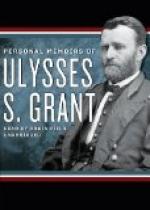In the spring of 1848 a party of officers obtained leave to visit Popocatapetl, the highest volcano in America, and to take an escort. I went with the party, many of whom afterwards occupied conspicuous positions before the country. Of those who “went south,” and attained high rank, there was Lieutenant Richard Anderson, who commanded a corps at Spottsylvania; Captain Sibley, a major-general, and, after the war, for a number of years in the employ of the Khedive of Egypt; Captain George Crittenden, a rebel general; S. B. Buckner, who surrendered Fort Donelson; and Mansfield Lovell, who commanded at New Orleans before that city fell into the hands of the National troops. Of those who remained on our side there were Captain Andrew Porter, Lieutenant C. P. Stone and Lieutenant Z. B. Tower. There were quite a number of other officers, whose names I cannot recollect.
At a little village (Ozumba) near the base of Popocatapetl, where we purposed to commence the ascent, we procured guides and two pack mules with forage for our horses. High up on the mountain there was a deserted house of one room, called the Vaqueria, which had been occupied years before by men in charge of cattle ranging on the mountain. The pasturage up there was very fine when we saw it, and there were still some cattle, descendants of the former domestic herd, which had now become wild. It was possible to go on horseback as far as the Vaqueria, though the road was somewhat hazardous in places. Sometimes it was very narrow with a yawning precipice on one side, hundreds of feet down to a roaring mountain torrent below, and almost perpendicular walls on the other side. At one of these places one of our mules loaded with two sacks of barley, one on each side, the two about as big as he was, struck his load against the mountain-side and was precipitated to the bottom. The descent was steep but not perpendicular. The mule rolled over and over until the bottom was reached, and we supposed of course the poor animal was dashed to pieces. What was our surprise, not long after we had gone into bivouac, to see the lost mule, cargo and owner coming up the ascent. The load had protected the animal from serious injury; and his owner had gone after him and found a way back to the path leading up to the hut where we were to stay.




